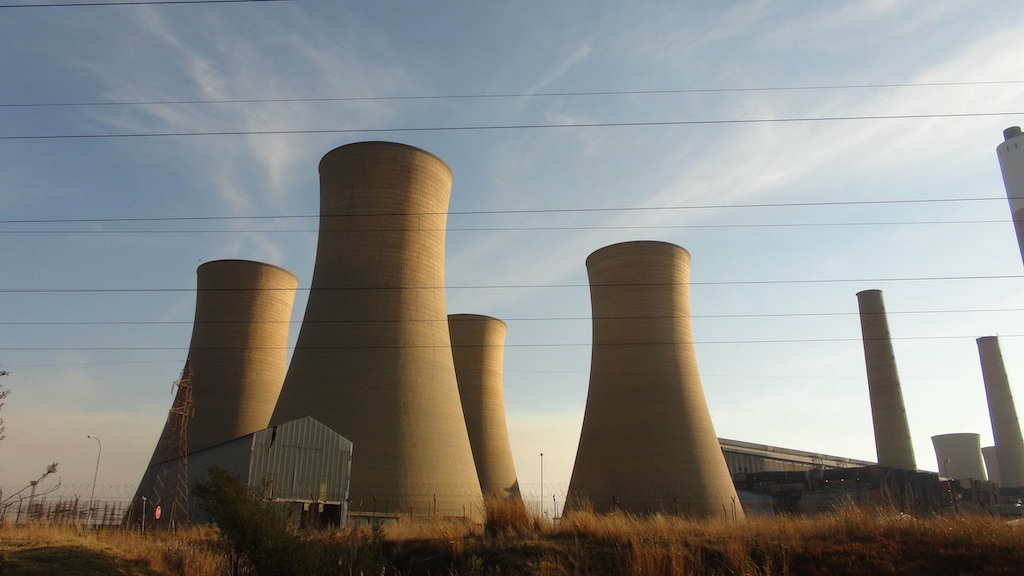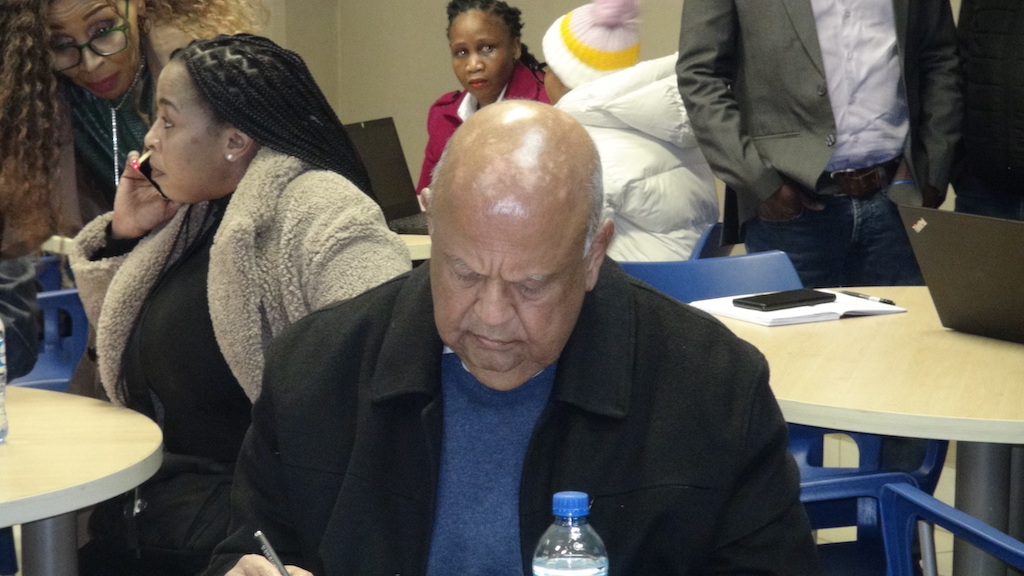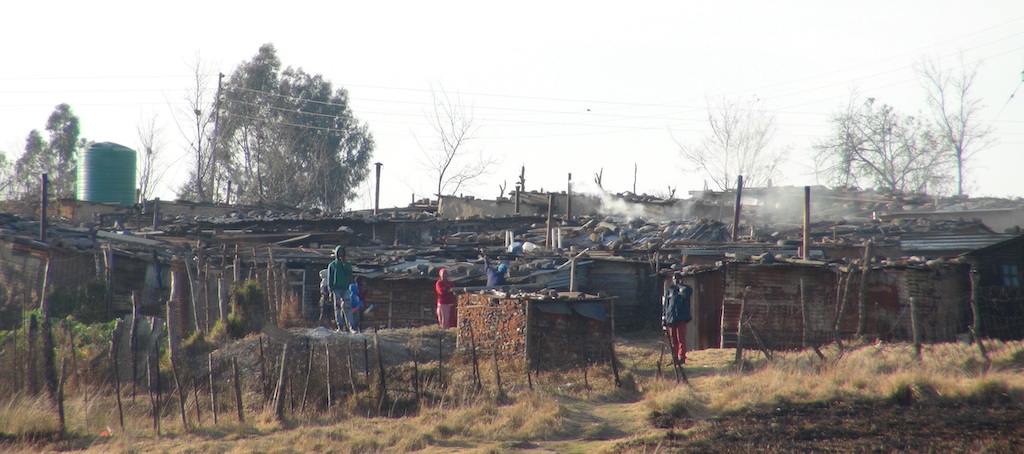
13 Jul Training ramps up at Komati
Thabo Molelekwa gets an update on the training and community support programmes taking shape at Eskom’s pilot renewable energy plant

Blueprint for the just energy transition: Banks of solar panels are being erected around Komati’s old chimney stacks. Photo: Thabo Molelekwa
Eskom will start reskilling programmes during August and September for its employees and community members at Komati power station, the facility pioneering the transition from coal to renewables in Mpumalanga province.
According to an Eskom spokesperson, four employees who will provide the training are starting a trainer’s course this week at the South African Renewable Energy Technology Centre in Cape Town. “They will be trained as trainers to come back to this facility and train other people,” said Vikesh Rajpaul, general manager of Eskom’s Just Energy Transition unit.
He added that in respect of uplifting surrounding communities, a call for applications would be going out this week to invite locals to participate in soft skills training. “We want to start that by the end of this month, or at the absolute latest in early August,” he said.
An investigation by Oxpeckers Investigative Environmental Journalism and Climate Home News in April 2023 found a major skills gap in coal-reliant communities in Mpumalanga and a lack of clarity on how funds for reskilling would be used (see Mind the green skills gap).

Vikesh Rajpaul: ‘We’re not doing this in isolation, and it’s not limited to Eskom employees only.’ Photo courtesy Eskom
Training centres
In an interview with Oxpeckers on July 7, Rajpaul said Komati is setting up a training facility that will have two training centres. The centres will focus on renewable energy skills, such as wind turbine maintenance and installing solar PV systems, and agrivoltaics – the simultaneous use of areas of land for both solar panels and agriculture.
“We’re also looking at soft skills training for community members, such as project management, welding courses, negotiation skills, presentation skills, business report writing and skills needed for the establishment of SMMEs [small, medium and micro enterprises].”
Rajpaul added that Eskom intends using Komati as a training hub for the province. It would be working with technical and vocational education and training (TVET) colleges in Mpumalanga in order to provide a consolidated programme of training, development and community upliftment, he said. Mpumalanga has three TVET colleges that fall under the department of higher education and training, and focus on “preparing students to become functional workers in a skilled trade”.
“We’re not doing this in isolation, and it’s not limited to Eskom employees only,” Rajpaul said, referring to fears expressed by many Oxpeckers interviewees that only employees would benefit from the renewables transition.
Repowering and repurposing
To make Komati’s transition possible, in November 2022 the World Bank approved a $497-million (about R9-billion) concessional loan facility to Eskom for the Komati repowering and repurposing project. Of this amount, $47.5-million came from the Canadian Clean Energy and Forest Climate Facility, and a $10-million grant from the Energy Sector Management Assistance Programme.
According to the World Bank, these funds will support Eskom in decommissioning the 56-year-old Komati coal-fired power plant, repurpose the project area with renewable energy and batteries, and create opportunities for workers and communities. If successful, the World Bank said, the project could provide a blueprint for the just energy transition in South Africa and beyond.
Rajpaul told Oxpeckers during a media tour of Komati organised by the Presidential Climate Commission that the R9-billion World Bank loan has three components Eskom has to fulfil: the decommissioning of the Komati plant ($33.5-million funding allocation); repurposing of the project area with hybrid renewables – solar, wind, batteries and a synchronous condenser ($416-million); and minimising the socio-economic impacts of the plant closure and creating opportunities for workers and communities ($47.5-million).
“It is to fund the repurposing and the repowering as well as, where required, the site rehabilitation,” he said. “So it is only for Komati power station.”
According to Rajpaul, just under 10% of the total loan will be allocated to address community improvement initiatives. “This speaks to the agrivoltaics, the containerised microgrid manufacture, as well as the establishment of the training centres,” he said. The World Bank, together with the Global Energy Alliance for People and Planet, are funding the Komati Training Facility.

Energy security: Minister of Public Enterprises Pravin Gordhan addressed concerns about the reduction in megawatts at Komati. Photo: Thabo Molelekwa
The megawatts
Repowering will see Komati produce about 340 megawatts (MW) of new generation capacity: 50MW solar PV, 70MW wind power and 150MW battery energy storage. Eskom is also looking at a synchronous condenser to be installed at the site, which will improve the plant’s power factor and reduce the reactive current required from the grid.
The station produced 1,000MW when it was originally commissioned, and concerns have been expressed about the reduced megawatts that will be produced through renewables compared to the 1,000MW when it was coal-fired.
“We acknowledge that a megawatt from renewables is not the same as a megawatt from coal,” Rajpaul said. “You cannot build all of the capacity, and it’s not our intention to replace all the capacity that the power station was generating, [but] it forms part of the bigger provincial initiative.”
The Department of Mineral Resources and Energy determines the new generation capacity, he added, so Eskom acknowledges that the station capacity that will come on board is not the same as the station capacity that was shut down. “But from a regional perspective and from a provincial perspective and from a country perspective, there’s a need for us to build a lot more generation capacity,” he said.
Speaking to the media, Minister of Public Enterprises Pravin Gordhan addressed the concerns about the reduced megawatts, saying other power stations will compensate for what is lost at Komati “over a period of time”.
“What we want in South Africa sooner rather than later is energy security,” Gordhan said. “There must be enough megawatts for every household. There must be enough megawatts for our economy, and there must not be load shedding in the future.”

Uplifting local residents: US$47.5-million is dedicated to minimising the socio-economic impacts of the plant closure and creating opportunities for workers and communities. Photo: Thabo Molelekwa
Pilot for transition
Being the oldest coal-fired power station in South Africa, Komati was the first to be decommissioned and is being used as a pilot for transition in South Africa.
“It had already been mothballed back in the 1990s, and then it was brought back to service for 10 years. By 2022 it was beyond its design life, so it was no longer economical for Eskom to run it,” Crispian Olver, executive director of the Presidential Climate Commission, told Oxpeckers.
According to Olver, even before the government started talking about energy transition and moving into renewables, Komati had reached the end of its life. “So it would be a mistake to look at Komati and say [it is shut down] because we are doing this transition to renewable energy; that’s actually not the reason,” Olver explained.
After it was decided to decommission Komati, Eskom still built two new coal-fired power stations, Medupi and Kusile. “So we were building new stations at the same time as taking the old ones off,” he said. “The way that power stations are closed is important because as we shift out of coal and into renewables, it’s important that we get this [Komati] decommissioning process right.”
Thabo Molelekwa is a freelance health and environmental journalist, and an alumnus of the Oxpeckers #PowerTracker training programme. This investigation was supported by the African Climate Foundation’s New Economy Campaigns Hub
